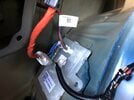Welp, can confirm the old port doesn't have a resistor on Prox. Lame. Well, good news is, the Prox signal was split in 2 pins (copied/shorted to both) probably for this very reason (and Gen3 has 2.7k between the Prox pin and Gnd). So I just have to add the resistor that changed places, now we have 100% compliance and, in effect, this circuit should "look exactly like" a Gen4 port.

UNTESTED AS OF THIS POST. I'M PROCRASTINATING BECAUSE I FEAR ANOTHER LETDOWN
So, off to tomorrow to slay the procrastination demon and face the possibility of another hopes-up/letdown. hahaha
UNTESTED AS OF THIS POST. I'M PROCRASTINATING BECAUSE I FEAR ANOTHER LETDOWN
So, off to tomorrow to slay the procrastination demon and face the possibility of another hopes-up/letdown. hahaha
Last edited:



